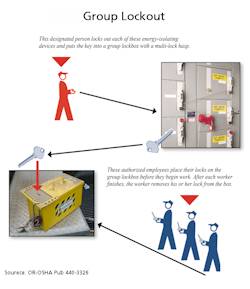Traditional Lockout vs. Group Lockout
Traditional Lockout
Under traditional lockout, each authorized employee places their personal lock on each energy-isolating device before beginning service work, and then removes that lock after the work has been done. Service work involving many employees and many energy-isolating devices can make traditional lockout complicated.
Group Lockout
In many workplaces, however, a group of authorized employees may need to service equipment that has several energy sources and several energy-isolating devices. To be most effective and ensure lockout/tagout, authorized employees may perform a group lockout/tagout.
Under the standard's group lockout/tagout requirements, a single authorized employee must assume the overall responsibility for the control of hazardous energy for all members of the group while the servicing or maintenance work is in progress. The authorized employee with the overall responsibility must implement the energy control procedures, communicate the purpose of the operation to the servicing and maintenance employees, coordinate the operation, and ensure that all procedural steps have been properly completed.
Example of the group lockout steps for a common process using a group lockbox.
- A designated, authorized employee in the group secures each energy-isolating device with a personal lock.
- The same designated, authorized employee places the key that fits each lock in a group lockbox with a multilock hasp.
- The other authorized employees in the group secure the lockbox - they attach their personal locks to the box - before beginning their service work.
- After each employee finishes service work on the equipment, that employee removes their personal lock from the lockbox.
- After all the employees have finished their service work and removed their personal locks from the lockbox, the designated, authorized employee who placed the key in the box removes it.
- The designated, authorized employee uses the key to remove the lock from each energy-isolating device.
Knowledge Check Choose the best answer for the question.
3-6. When equipment servicing or maintenance must be performed by a group of authorized employees, what process may be used to most effectively perform lockout/tagout?
You forgot to answer the question!

